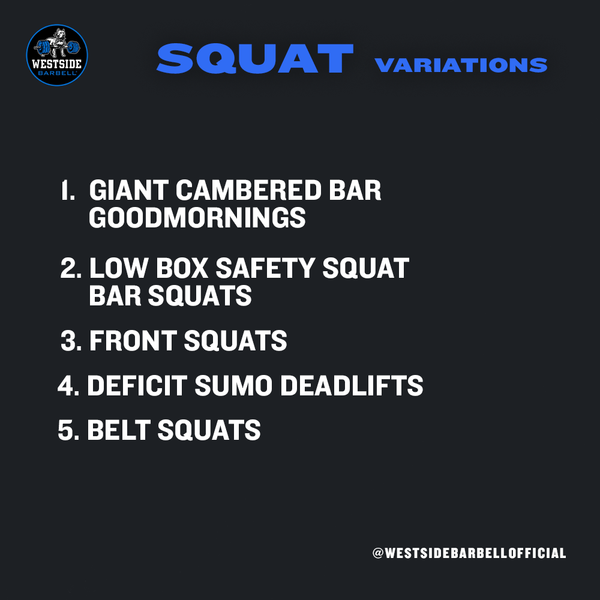WSBB Blog: 5 Accessory Exercises for the Squat

Tags: Goodmornings, Sumo Deadlifts, Box Squats
Time to Read 3.5min
The foundation of an elite total always lies within the squat. It is the first lift of the day, and the lift where you set the tone for the rest of the meet. Going three for three and hitting a PR can set you up for a great day and total, however a bad squat performance can have you bombed out and watching the rest of the meet from the cheap seats.
In this article we will cover five accessory exercises that we use at Westside Barbell to build some of the strongest squats in the world.
Giant Cambered Bar Good-mornings
Potentially the greatest posterior chain exercise a lifter can add to their arsenal, the giant cambered bar good mornings
will directly target the glutes, hamstrings, lower and mid back paraspinal muscles. This lift can be done full range of motion, or the bar can be suspended for concentric focused good-mornings. At Westside, we will create variations of this exercise by attaching forward pulling bands, attaching doubled mini or monster-mini bands on a suspended bar set up, or by attaching chains.
This lift can be done as a main exercise or an accessory exercise, the recommended sets and reps for accessory work would be 4 x 8-10 reps for higher volume or 5 x 3-5 reps for higher intensity lower volume accessory work.
Low Box Safety Squat Bar Squats
This exercise is great for lifters who struggle with quadriceps strength and development, as well as lifters who struggle with depth. It is a simple exercise to set up, we recommend the box height to be two mats below what you would typically squat to on DE lower day. Considering the safety squat bar places the bar in a high bar position, this exercise will blast the quads.
For accessory work we will do this exercise for 3-5 sets of 6-8 reps with a moderate weight, or 2-4 sets of 10-12 reps with a lighter weight.
Front Squats
An excellent exercise that will assist in developing strong quadriceps, as well as improving your ability to engage your upper back and brace your trunk. Front squats can be done by either free squatting or squatting to a box. At Westside, we will typically attach a 100-150lb band to the bar and front squat to a box.
These will be done for 3-5 sets of 5-8 reps, focusing on hitting controlled reps each set. The bands challenge your upper back posture, so failure to maintain control of each rep can easily result in the bar sliding down your arms onto the floor. This exercise can also be a great teaching tool for someone who has trouble locking in their upper back and maintaining neutral thoracic positioning during a heavy squat.

Deficit Sumo Deadlifts
This exercise can be done for volume sets and reps, however at Westside we typically do these immediately after DE lower squats for six to eight singles. We will utilize a 2-4” deficit against monster mini bands, with the bar weight being between 75-85%. To focus on accessory rep work you would want to remove the bands, and perform the lift for 4-6 sets of 5-8 reps.
To add additional variation to the exercise, you can do these Romanian deadlift style, pausing each rep at the bottom before the weight touches the floor.
ATP Squats
When building a strong squat you will need to develop strong hips/glutes, and here at Westside we accomplish that by putting in brutal workouts on the belt squat. We squat with and without a box on the belt squat, usually changing the style workout to workout. We also belt squat while carrying a barbell either on our back, in a front squat position, or in a zercher squat position to create additional variations of the exercise.
We recommend keeping the volume high with this exercise, with sets between 4-6 and rep ranges between 10-15 sometimes working all the way up to 20 reps. The belt squat is a safe way to add additional squat reps into your workout while reducing the risk of injury when free squatting in a fatigued state with a barbell.
As mentioned before, having a strong squat is an absolute necessity if you want to be a successful powerlifter. By implementing the proper accessory exercises, you can strengthen your weaknesses to increase your total while simultaneously cleaning up a good amount of movement issues beginner and intermediate level lifters deal with. Before you go to a Physical Therapist, consider the fact that you’re not correctly structuring your accessory exercises to properly develop the involved muscle groups.
Unless you’re injured, it is more likely you have a muscular weakness not a “movement dysfunction”. Throw a few of these exercises into your lower body accessory exercises and watch the dysfunctions and weaknesses disappear. This shit isn’t magic, it is training done the right way - the Westside way.




